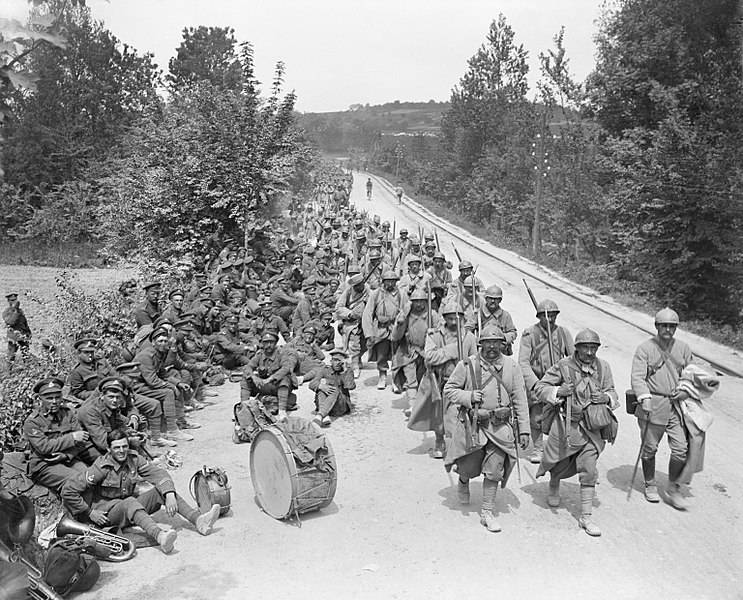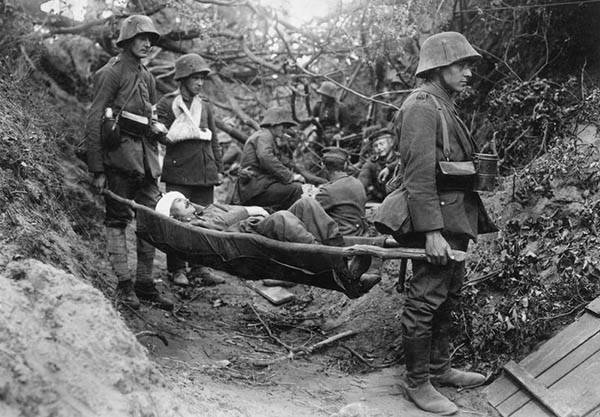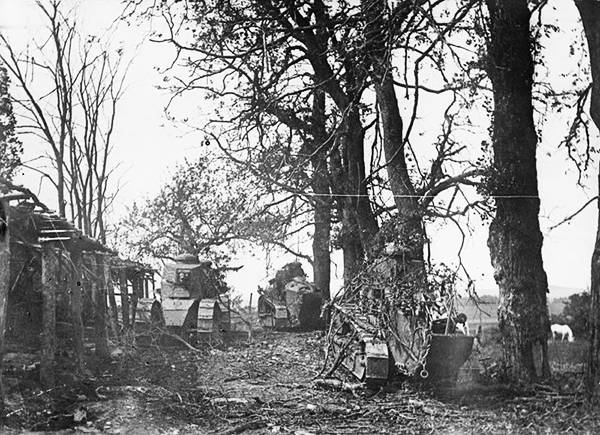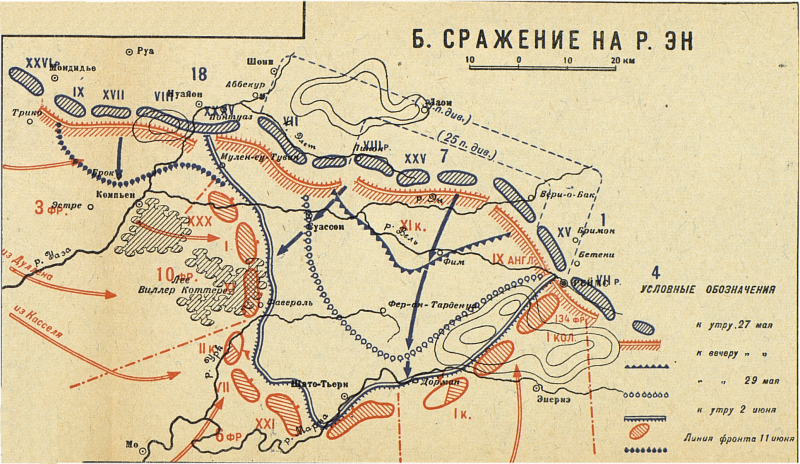German divisions in 56 kilometers from Paris
As a result, the overall strategic position of the German army on the Western Front deteriorated. To the ledges at Amiens and in Flanders, a projection on the Marne was added now, which significantly increased the total length of the front and required large forces to hold it. In addition, the presence of protrusions provided the Anglo-French troops with convenient starting areas for counterstrikes into the flanks of the German armies.
Operation plan
Despite the general failure of the attack in Picardy and Flanders (with some success in capturing territory and pushing the enemy) and the heavy losses sustained by the German army in March and April 1918, the high command did not abandon further attempts to defeat the armed forces of the Entente on the Western Front. “We,” said Ludendorff, “had to retain the initiative that we had in our hands, and after the first big blow, at the first opportunity to inflict the second.”
Immediately after the end of the battle on the river. Fox began to develop a new offensive plan. Germans still sought to defeat the British army. However, in the course of the previous battle, the Allied command concentrated considerable reserves in Picardy and Flanders. As a result, the resumption of operations in the area inevitably came across a strong defense and a ready and strong enemy. Therefore, the German High Command decided to expedient to divert some of the reserves of the Entente located there, having launched an offensive in the area between Reims and r. Oise, and then again to attack the British on the Somme or in Flanders.
The offensive was to take part 18-I, 7-I and 1-I armies of Army Group Crown Prince Wilhelm. The success of the offensive in the area posed a direct threat to Paris, which was only 120 km from the front line and therefore inevitably had to cause the transfer of French reserves to the point of breakthrough. The operation was planned to start on 27 in May with a blow from the 7 Army and the right flank of the 1 Army in the Abbekur, Brimon section with a stretch of about 70 km. On May 30, the left flank of the 18 Army was connected to the operation. The breakthrough front expanded to 86 km. And in early June it was planned to launch an offensive on the Mondidier, Noyon sector. Thus, the German offensive was to consist of several interrelated army operations, whose common front, gradually expanding, would have reached 120 km. At the same time, it was impossible to organize an offensive on such a front, since part of the artillery that participated in the March operation was not yet time to redeploy.
Thus, initially the offensive had a limited goal - to divert the enemy’s forces from the intended point of breakthrough, so that the offensive could continue in Flanders. Planned to reach p. Enes have Soissons. A few days before the start of the operation, it was decided to spread the offensive on both sides of Soissons and a few kilometers south of the r. Vel.

The third battle in Ene. French infantry on the march, the British are resting along the road
Forces of the parties. Training
By May 27, the Germans concentrated 34 divisions in the area of the planned strike (21 in the first echelon, 7 in the second, 6 in the third), 5263 guns (3632 light and 1631 large and special power), 1233 mortars and about 500 aircraft. They were opposed by the 6th French Army, located on a 90-kilometer front (on the right flank was the 9th British Corps). It had at the forefront 11 infantry divisions, supported by 31 territorial battalions and 27 machine gun companies. There were 4 infantry divisions in the army reserve, 8 infantry divisions and 2 cavalry divisions in the reserve of the main command. French artillery totaled 1400 guns, aviation - 14 squadrons. The German troops at the breakthrough site thus had a double superiority over the enemy in the number of first-tier divisions and an almost fourfold superiority in artillery.
The conditions for the attack were rather complicated. German divisions had to overcome the rivers Ellet, Urk, Vel and Marne. The terrain abounded in heights and favored the conduct of defensive operations. However, the French, considering their positions to be quite strong by nature, did not pay enough attention to their engineering equipment. The tactical depth of the French defense was from 8 to 12 km. The first fortified strip to a depth of 4 km consisted of three or four lines of trenches. Behind it was the second defensive zone, consisting of two or three lines of trenches. In 5 - 6 km, there were separate resistance nodes behind the second lane. At the same time, the French defense continued to be built on the old principles of retention at all costs in the front page. That is, the concentration of the main forces of the French on the front line of defense allowed the Germans to bring down all the power of their fire on this group, crush it and create favorable conditions for further breakthrough.
Based on the experience of the March and April battles, the German command supplemented and specified the instructions issued earlier on conducting an offensive battle. The additions "consisted in an even lowering of the infantry, in increasing the importance of tactics of small strike groups, in improving the coordination of the work of ... infantry with artillery." The new instruction from 17 on April 1918 of the year distinguished two types of offensive: 1) methodical attack against an enemy occupying a solid fortified band, and 2) an attack of interband space that does not have a solid front. In the first case, reinforced artillery preparation was used, and the attack of the infantry itself was carried out according to a precisely developed plan under the direct supervision of the high command. To attack the inter-band space, a long-term artillery preparation was deemed unnecessary. The success of the battle in this case, in the absence of a moving shaft of fire, depended on the initiative of junior commanders, the well-organized interaction of infantry with escort artillery, the rapid suppression of the resistance units and the machine-gun nests of the enemy. The artillery preparation was supposed to go 2 h. 40 min. With the end of the artillery preparation, the artillery created a mobile fire roll, which was supposed to advance in jumps in 200 m, separated by intervals in 6 minutes (1 kilometer in 40-50 minutes). To prevent the escort artillery from lagging behind, artillery platoons were attached to the head infantry battalions. In the infantry units the number of machine guns was increased. Machine guns were also armed with wagons and transports to protect against enemy air raids. The troops received the first anti-tank rifles.
The Germans paid special attention to keeping the place and time of the operation secret. Divisions designed to strike, moved to these areas immediately before the start of the attack. Special order for the 7 of the German army in the headquarters of the corps and divisions were appointed officers responsible for the implementation of measures to ensure secrecy. In the area of advanced positions it was forbidden to create structures that could not be quickly disguised. Enhanced was the control of radio and telephone calls. Secret documents were forbidden to pass below the regimental headquarters. The troops moved only at night. For the purpose of misinforming the enemy throughout the French front, they were demonstratively preparing for an offensive, especially against the British forces, where the allies most of all were expecting a German strike. In the 2 and 18 of the German armies, the impending offensive was deliberately announced. In the rear of the army group of Crown Prince Rupprecht, strong artillery remained, false troop movements were organized, and radioactivity increased. German planes regularly attacked the rear of the British.
This allowed to keep the secret until May 26. The Allied Command did not expect the Germans to strike on this sector. Four British divisions, drained by fighting in Flanders and on the Lys River in April, were even set aside for rest here. On May 25, the commanders of the British divisions received a message from the French General Staff: "There is no indication, in our opinion, that the enemy conducted a training that would allow him to launch an attack tomorrow." Only in the morning of May 26, the French captured two prisoners who warned the Allies about the impending attack of the German army 27 - May 28. The French command quickly began to transfer reserves to the front of the 6 Army and bring its troops into full combat readiness, but did not have time to take effective measures to repel the threat.
Offensive
27 May, at 2 at one o'clock in the morning, suddenly, without prior zeroing, 4400 German guns opened fire on the 71 kilometer front between Reims and Soissons. The shooting was carried out on the entire tactical depth of the defense of the 6 of the French army and was corrected by observers from tethered balloons and airplanes. Already during the first minutes numerous explosions of ammunition occurred in the French positions. A large number of French guns were destroyed by direct hits. Gases of chemical projectiles filled the entire area of the 6 French army, the connection was broken. The defense of the enemy was completely suppressed. Thus began the third stage of the German Spring Offensive on the Western Front.
After more than two hours of artillery preparation in 4 hours. 40 minutes in the morning, under the cover of a fiery shaft, the German infantry went on the attack. In contrast to the previous operations, the firing shaft was double. In front of the main rampart, immediately preceding the infantry and consisting of fragmentation projectiles, a second ramometer of chemical projectiles was moving, which was to drive the enemy’s infantry into its shelter and shelter. The French artillery was so paralyzed by a short but powerful artillery preparation that it could not seriously interfere with the German infantry. By 11 hours, the troops of the 7 of the German army, without encountering serious resistance, captured Chemin de Dame and reached the r. Enu The Germans advanced 8 - 9 km and crossed the main line of defense of the enemy. Capturing bridges over the river. The Enu, which the Allies did not have time to destroy, the Germans crossed over to the southern coast. Parts of the German infantry on a broad front continued their rapid advance to the south. By the end of the day they reached the river. Vel and in places forced it.
Thus, the results of the first day of the attack exceeded the expectations of the German command. Allied defense was broken through to the depths. German troops marched in the center, in a straight line, about 20 km. On the flanks, the Allies put up more resistance. The main goal of the offensive - to pull the Allied reserves from Flanders and Picardy - was achieved. 10 infantry and 3 cavalry divisions of the 5 of the French army were urgently transferred to the place of the breakthrough.
The offensive continued at night and the next day with the same force. At noon, May 28, the 7 Army reached heights south of the r. Vel and here, in accordance with the plan of operation stopped. However, the quick and decisive success of the German divisions inspired the high command. In 14 hours 36 minutes the troops were ordered to continue the offensive. In connection with the lag of the flanks, special attention was paid to the development of a breakthrough towards Reims and Soissons, since without this further advance to the south was dangerous. The order emphasized the need to master Soissons. In this case, the French will be forced to withdraw their troops from the territory between the rivers Ain and Oise, which will create favorable conditions for the 18 Army to launch an offensive in the direction of Compiegne. The ultimate goal of the 18 th, 7 th and 1 th armies was to reach Compiegne, Dorman, Epernay. Thus, the operation, planned as an auxiliary and distracting one, developed into a decisive offensive with the task of winning as much space as possible in the Paris direction.
May 28's particularly stubborn fights followed Soisson. The main blow of the German troops in this area was taken over by the 39-I French Infantry Division. Attacked from the front and the flanks, it began to retreat west to Soissons, opening the front. The Allied divisions, which were urgently brought to the breakthrough site, entered the battle in units as they arrived and were unable to close the gap, which was widening with each passing hour. By the end of the day, the German troops advanced on 6 - 8 km. In the area between the river. Enoy and Reims 6-I French army retreated from fortified positions. Behind her were only the advanced fortified lines of Paris. On the night of May 29 Soissons fell.
The Russian military historian, General Andrei Zayonchkovsky, wrote: “The French managed to send nine fresh divisions into battle, but they could not properly organize the management of the quickly retreating troops. As a result, the Germans, who displayed extraordinary energy, manage to advance 6 – 8 km in a day, expand the front of their offensive to 60 km (in the east almost to Reims, and in the west behind Pinon) and seize prisoners for 2 on the day of operation over 20 000. In Paris, which began again to be bombarded with 210-mm cannons, a panic arose and evacuation began. ”
The French capital was fired from heavy guns, the city was raided by German bombers. Because of the danger of the 28 position in May, 10 infantry divisions from the Northern Army Group, as well as 4 infantry divisions and the 2 Cavalry Corps from the reserve grouping were sent to the battle area. However, they arrived at the breakthrough site at different times, during the 29 of May - 1 of June, and in parts. The French command experienced great difficulties in organizing troops on a continuously attacked and constantly changing front.
On May 29, the Germans continued the onslaught, advanced 12 km in the center, and took the Soissons line, west of Fere-en-Tardenoi, Betini, and continued the offensive towards Marne. The French were in no hurry to strengthen the center, believing that Marne would stop the Germans, but continued to strengthen the flanks. In the evening of May 29, Petain ordered that the 30 May launch a counterattack on the flanks of the German ledge and prevent the enemy from crossing the Marne. But the planned counteroffensive did not take place. On May 30, the German command expanded the offensive by launching the left-flank corps of the 18 army and the right flank of the 1 army into battle. Particularly vigorous offensive developed in the southern direction and reached the right bank of the Marne. The Germans captured 800 guns and already 50 thousand prisoners of war (mostly French). But it was the last day of the great success of the German divisions. On the southern coast of the Marne, the French managed to organize a defense. On the flanks, the German troops did not achieve much success.
31 May Germans especially aggressively attacked in the direction of Château-Thierry. They were opposed by the Moroccan division. She blocked the highway to Paris and steadfastly opposed 3 to the German divisions. Soon the Moroccans reinforced two French divisions. Together with them, the regiments of the tiralliers, the Zouavs (the French colonial troops), the Russian legion counterattacked and rejected the enemy. The stubborn battle went all day on the Reims Heights, but it was not possible to take the city itself.
The battle of Chateau Thierry continued in the first days of June. American troops have been transferred here. Hurriedly creating new fortifications in the areas of German breakthroughs, American soldiers dug trenches at night from 1 to June 2, often using only bayonets. In such primitive trenches it was possible to hide only in the supine position. But this was enough to stop the advance of the German infantry and keep the defense for two days. This made it possible to prepare new, more serious defensive lines of fortifications in the near rear and finally stop the enemy offensive. By 3 June, the German divisions approached Paris already at a distance of 57 kilometers, but they were already exhausted.
The French managed to concentrate on the front of the German offensive large forces, including the Americans. The battles now proceeded more systematically, were accompanied by frequent counterattacks and passed into positional ones. German divisions lost their initial strike force, due to the lengthening of the front, their operational density decreased. And the pace of the approach of French reinforcements was higher than the rate of introduction of German units into the battle. As we approached Paris, the resistance of the French troops intensified. As a result, the balance of power gradually changed in favor of the allies. Also, the course of the German offensive was adversely affected by the constant lagging of the flanks. The situation with the work of the rear was also bad. The central corps of the 60 Army advancing on 7 km experienced great supply difficulties, which were carried out along the only broad-gauge road east of Soissons. In the following days, the offensive fades out, and June 5 stops first on the flanks, and then in the center. 6 June 1918, the German command ordered all troops to stop at the lines reached.
British military historian Neil Grant noted: “The advantage of the attack, like the two previous attacks, was in its suddenness. This section of the front was not considered by the British as a possible battlefield, and therefore troops who needed to rest were often sent here. But when the Germans moved west towards Paris, they stumbled upon a defensive ring, hurriedly built by Petain, and were violently attacked by the 2-American division in the strategic location of Chateau-Thierry.
To eliminate the threat to the right flank of the 7th Army in the Soissons region and to straighten the front between the ledges at Amiens and the Chateau-Thierry, the German command launched an offensive of the 9th Army on the river on June 13–18. Oise in the general direction of Compiegne. However, this time the Germans failed to create significant numerical superiority. 21 divisions of the 18th German army opposed 33 divisions and 15 on the 4-km front from Mondidier to Noyon tank groups (160 tanks) of the 3rd French army. The preparation of the offensive was carried out hastily, without observing the necessary secrecy. French aerial reconnaissance revealed the training of the Germans. These data were confirmed by the testimony of prisoners. Therefore, the French command, taking into account the experience of the Battle of Aene, began the transfer of the bulk of the troops of the 3rd Army to the second position and issued the necessary orders for artillery counter-training.
On June 9, artillery preparation began at night and in 4 hours of 20 minutes the German infantry launched an offensive. The Germans wedged in a French location on 10 km during the first two days. Until Compiegne remained only 7 km. However, in the morning of June 11, the French divisions, supported by tanks, counterattacked the Germans and pushed them a little. June 4 13 th German army offensive was stopped, not reaching the task.

German soldiers wounded during the battle of Ene. June 1918 of the year
Results
As a result of the May 27 6 offensive on June 1918, the German army broke into the French defenses on the 80-kilometer front and deepened their location on the 60 km. Long-range guns already reached Paris. The main objective of the operation - to draw back reserves from the English front - was achieved. But the Germans, after the first great success, continued the offensive and could not achieve the defeat of the enemy.
Militarily, thanks to the precise organization of artillery training and good tactical training, German troops showed an unprecedented attack rate for the Western front: 20 km on the first day and 10-12 km on the second day. The advance was largely facilitated by the fact that the French command concentrated the main forces of the 6 Army in the first position. This made it easier for the Germans to quickly defeat them. A certain role was played by the fact that the French command did not manage to destroy the bridges across the r. Enu Then the French managed to quickly redeploy reinforcements and the German troops exhausted, lost their strike power and numerical superiority, failed to save the breach and develop an offensive against Paris. Front stabilized. Allied losses amounted to about 127 thousand people (France - 98 thousand, Britain - 29 thousand). German troops also suffered heavy losses — about 100 thousand people killed, wounded and captured. Losses of the German army in the battle on the river. Oise with 9 June amounted to 25 thousand people, the French - about 40 thousand
Thus, the 27 attack of May - June 13 worsened the overall strategic position of the German army on the Western Front. To the ledges at Amiens and in Flanders, a projection on the Marne was added now, which significantly increased the total length of the front and required large forces to hold it. In addition, the presence of protrusions provided the allies with convenient springboards for counterattacks into the flanks of the German troops.
Thus ended the last battle of the series of battles under the general name Spring Offensive of the Germans. The tactical success of the operation is obvious: the German armies took up in all battles and advanced on some lines more than 50 km, the allies lost more than 850 thousand people killed, wounded and captured. However, the German losses were almost the same: about 700 thousand people. The strategic tasks set by the German General Staff before the troops were not fulfilled. The allied forces could not be dismembered, the British “dumped into the sea”, and the French were rejected to Paris and forced to ask for peace. At the same time, Germany invested all the remaining forces and means in these operations, exhausted almost all of its reserves. The Austro-German intervention in Russia also played a negative role, swallowing up a significant number of divisions and cavalry in France, which did not allow to throw reserves and cavalry into the resulting gaps and strike first successes. The blockade and the long war have exhausted the military and economic capabilities of Germany. And the Allies had the opportunity to recuperate due to the lack of blockade, links to the colonies and the help of powerful United States. In France, the American divisions went in a continuous stream. As a result, American aid became the decisive factor in the war of attrition, in which, like the Germans, they almost completely spent their resources.

French Renault FT-17 tanks are in reserve during the battle of Ene. May 1918 of the year

Information